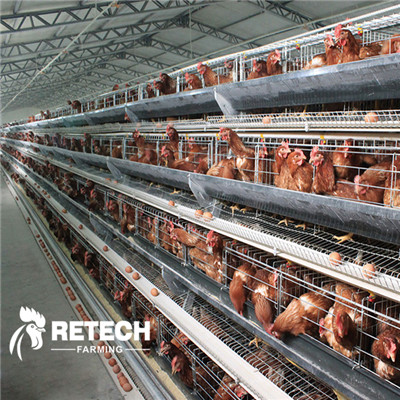Para masigurado yanmga inahing manokgumawa ng mas maraming itlog, kailangan ng mga magsasaka ng manok na madagdagan ang liwanag sa oras. Sa proseso ng pagpuno ng liwanag para sa pagtula ng mga hens, ang mga sumusunod na punto ay dapat bigyang pansin.
1. Makatwirang paglalapat ng liwanag at kulay
Ang iba't ibang kulay ng liwanag at wavelength ay may iba't ibang epekto sa mga manok na nangangalaga. Sa ilalim ng parehong mga kondisyon ng iba pang mga kondisyon ng pagpapakain, ang rate ng produksyon ng itlog ng mga inahin na pinalaki sa ilalim ng pulang ilaw ay makabuluhang mas mataas kaysa samga inahing manoksa ilalim ng iba pang mga kulay ng liwanag, na sa pangkalahatan ay maaaring tumaas ng mga 10% hanggang 20%.
2.Tang tagal niya ay matatag at angkop
Ang pandagdag na ilaw para sa pag-aanak ay karaniwang nagsisimula sa edad na 19 na linggo, at ang oras ng liwanag ay dapat mula sa maikli hanggang mahaba, at ipinapayong dagdagan ito ng 30 minuto bawat linggo. Kapag ang pang-araw-araw na oras ng pag-iilaw ay umabot sa 16 na oras, dapat na mapanatili ang matatag na ilaw, at ang tagal ay hindi dapat maikli. Ang pinakamahusay na paraan ay upang madagdagan ang liwanag isang beses sa isang araw sa umaga at gabi.
3. Ang intensity ng liwanag ay pare-pareho at angkop
Para sa normalmga inahing manok, ang kinakailangang intensity ng liwanag ay karaniwang 2.7 watts bawat metro kuwadrado. Upang magkaroon ng sapat na pag-iilaw ang ilalim na layer ng multi-layer cage chicken house, dapat tumaas ang illumination sa disenyo, sa pangkalahatan ay 3.3~3.5 watts kada metro kuwadrado. Samakatuwid, ang 40-60 watts ng mga bombilya ay dapat na naka-install sa bahay ng manok. Sa pangkalahatan, ang taas ng mga ilaw ay 2 metro, at ang distansya sa pagitan ng mga ilaw ay 3 metro. Kung higit sa 2 hilera ng mga bombilya ang naka-install sa bahay ng manok, dapat silang ayusin sa isang cross na paraan. Ang distansya sa pagitan ng mga bombilya laban sa dingding at sa dingding ay dapat na kalahati ng distansya sa pagitan ng mga bombilya. Dapat ding bigyang pansin ang pagpapalit ng mga nasirang bombilya anumang oras. Punasan ang mga bombilya isang beses sa isang linggo upang mapanatili ang bahay sa lugar. angkop na liwanag.
Iwasang biglang buksan o patayin ang mga ilaw kapag madilim o maliwanag, na makakaistorbo sa mga manok at magdudulot ng stress reaction. Ang mga ilaw ay dapat na nakabukas at nakapatay kapag ito ay hindi madilim o kapag ang kalangitan ay may isang tiyak na liwanag.
Ang dahilan kung bakit naaapektuhan ng liwanag ang rate ng produksyon ng itlog ng mga manok
Sa unang bahagi ng tagsibol, ang oras ng sikat ng araw ay pinaikli, at ang epekto ng liwanag sa katawan ng manok ay nabawasan, na binabawasan ang pagtatago ng mga gonadotropin sa anterior pituitary gland ng manok, na nagreresulta sa pagbaba sa rate ng produksyon ng itlog ng mga manok.
Mga paraan ng pagbibigay ng artipisyal na pag-iilaw
Sa pangkalahatan, ibinibigay ang artipisyal na liwanag kapag ang natural na liwanag ay wala pang 12 oras, at dinadagdagan ito ng humigit-kumulang 14 na oras ng liwanag bawat araw. Upang madagdagan ang ilaw, mas mahusay na buksan ang mga ilaw dalawang beses sa isang araw, iyon ay, buksan ang mga ilaw sa 6:00 ng umaga hanggang madaling araw, at buksan ang mga ilaw sa gabi hanggang 20-22:00, at ang oras ng paglipat ng mga ilaw ay hindi kailangang baguhin araw-araw. Kapag nagdaragdag ng ilaw, ang supply ng kuryente ay dapat na matatag. Angkop na gumamit ng humigit-kumulang 3 watts ng ilaw kada metro kuwadrado sa bahay. Ang lampara ay dapat na mga 2 metro ang layo mula sa lupa, at ang distansya sa pagitan ng lampara at lampara ay dapat na mga 3 metro. Ang aparato ay dapat ilagay sa ilalim ng bombilya.
Angkop na light time para sa mga manok
Matapos magsimula ang produksyon ng mga manok, ang angkop na oras ng pag-iilaw ay dapat na 14 hanggang 16 na oras sa isang araw, at ang pag-iilaw ay dapat na humigit-kumulang 10 lux (katumbas ng 2 metro sa ibabaw ng lupa, at 1 watt ng liwanag bawat 0.37 metro kuwadrado). Ang oras ng liwanag ay hindi maaaring baguhin nang basta-basta, lalo na sa huling yugto ng pagtula ng itlog, mas hindi angkop na bawasan ang intensity ng liwanag o paikliin ang oras ng liwanag, ibig sabihin, ang liwanag ay maaari lamang tumaas, hindi bumaba, kung hindi, ang rate ng produksyon ng itlog ay lubos na mababawasan.
Mga pag-iingat
Para sa mga manok na may mahinang kalusugan, mahinang pag-unlad, magaan ang timbang, at wala pang 6 na buwang gulang, ang artipisyal na pagdaragdag ng liwanag ay karaniwang hindi isinasagawa, o ang supplementation ay naantala ng isang panahon, kung hindi, ang layunin ng pagtaas ng rate ng produksyon ng itlog ay hindi makakamit, kahit na ang isang pansamantalang pagtaas ay malapit nang humantong sa maagang pagtanda, ngunit ito ay magbabawas sa rate ng produksyon ng itlog sa buong taon.
Oras ng post: Hul-22-2022









